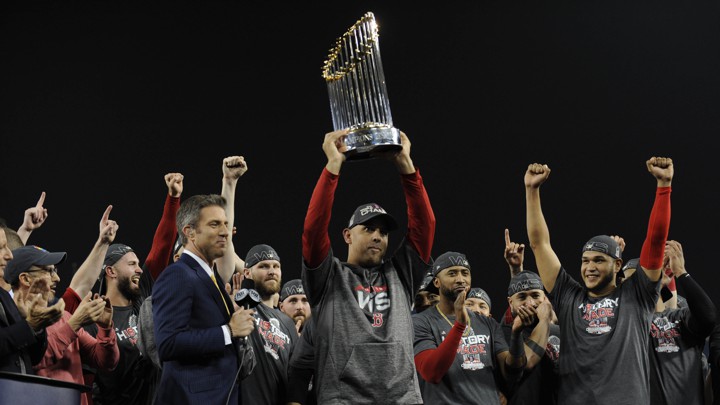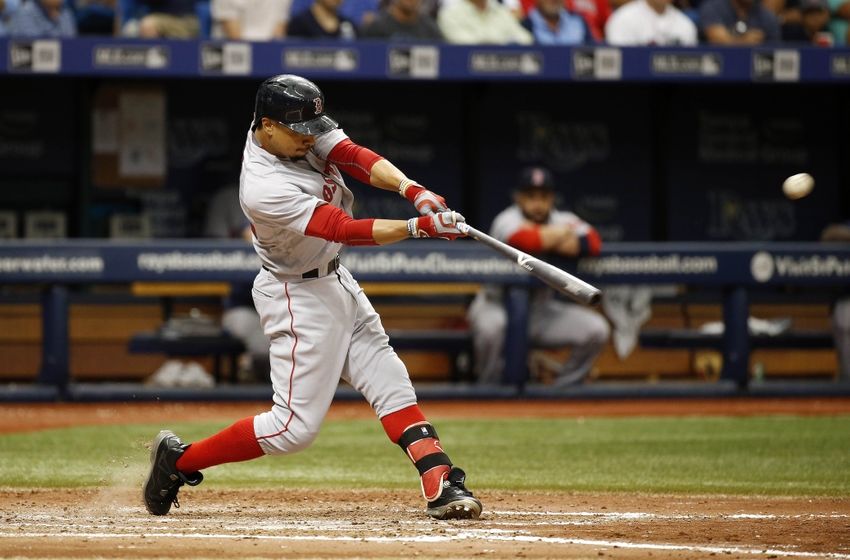 |
| Is 7 Boston's lucky number? (Slow Trav) |
The last time a year ended with a seven, the Red Sox won the World Series. Heading into 2017, they were
favored to win again, which would be their ninth in franchise history and fourth of this millennium. Here's how their seasons have played out in previous years ending in seven (a real mixed bag, with some great seasons offset by some terrible ones):
1907 (59-90, 7th place out of 8)
This was not a good year for the Boston Americans, who would change their name to the Red Sox the following year. A dark cloud hovered over the season following player-manager
Chick Stahl's suicide in late March, which left the organization scrambling to replace him on the eve of Opening Day. A franchise-record four managers presided over the club's second straight underwhelming season, although it represented an improvement over their 105-loss last-place finish the year before. Boston's offense was abysmal, averaging 3.12 runs per game and ranking last in scoring, steals, average, OBP, and OPS as none of the regulars batted .290 or posted a .700 OPS. As a result, the pitching staff received little run support and every hurler besides
Cy Young (21-15, 1.99 ERA),
Cy Morgan (6-6, 1.97 ERA), and
Beany Jacobson (two innings) ended up with a losing record. It would be 15 years before Boston endured another season so poor.
1917 (90-62, 2nd place out of 8)
After winning consecutive World Series in 1915-16, the Red Sox finished nine games out after battling the Chicago White Sox for much of the summer. Boston's offense was ordinary, ranking middle of the pack in most categories, but the pitching was phenomenal. 22-year-old
Babe Ruth won 24 games and fashioned a 2.01 ERA while completing 35 of his 38 starts -- most in the Majors. He was joined by another 20-game winner in
Carl Mays, who went 22-9 and had a slightly better season than Ruth in terms of run prevention (1.74 ERA). Despite all their talent, the Red Sox were unable to match the World Series-winning White Sox, who won another pennant two years later before forever going down in infamy as the Black Sox.
1927 (51-103, 8th place out of 8)
Everyone remembers this season for Ruth's 60 homers, but unfortunately none of them came for Boston. He was now entrenched with the Yankees and part of one of the greatest teams ever assembled in Murderer's Row. Boston, meanwhile, had been stripped for parts and lost over the 100 games for the third straight season. The lineup was once again last in scoring (plus all three rate stats) while none of the regular pitchers had an ERA under four. Unfortunately for the Red Sox, they would endure another half-decade of misery before Tom Yawkey purchased the club and began turning things around.
1937 (80-72, 5th place out of 8)
Boston's 80 wins were their most since 1917 as all of Yawkey's spending began to pay off. Having recently acquired stars such as
Joe Cronin,
Jimmie Foxx, and
Lefty Grove, Boston was finally moving in the right direction. While an improvement over recent editions, the offense was only middle-of-the-road and the pitching staff was thoroughly mediocre aside from Grove and
Jack Wilson. Most notable was the debut of 19-year-old second baseman
Bobby Doerr, who struggled initially (.626 OPS) but quickly established himself as one of the team's most valuable position players over the next decade and a half, punching his ticket to Cooperstown in the process.
1947 (83-71, 3rd place out of 8)
Hopes were high for Boston following its World Series appearance in '46, but a wave of sore arms dashed any hopes for a repeat.
Dave Ferriss,
Tex Hughson, and
Mickey Harris were all victims, causing the burden to fall on the shoulders of
Joe Dobson (a fine pitcher, but no ace) and
Denny Galehouse. The offense dropped off some as well, with several players like Doerr and
Rudy York proving unable to sustain their '46 performance. One player who did was
Johnny Pesky, who led the Majors in hits for the third straight year that he was active (excluding the war years of 1943-1945). Another was
Ted Williams, who won his second Triple Crown but was denied a second straight MVP award, as voters inexplicably chose
Dom DiMaggio's big brother from the pennant-winning Yanks.
 |
| Williams had superb individual seasons on 3rd place clubs in '47 & '57 (ABC News) |
1957 (82-72, 3rd place out of 8)
The Red Sox took over third place for good the day after Independence Day, but the highlight of the summer was Teddy Ballgame nearly hitting .400 again, ultimately settling at .388. As Williams told it, word had gone around the league that he could no longer pull the ball with power at age 38, leading opponents to abandon the shift against them. This opened things up for Williams, who also posted the second-highest home run total of his career with 38. Despite leading the Majors in hitting, OBP (.526), SLG (.731), OPS (1.257) and OPS+ (233), Williams lost out on another MVP to a Yankee center fielder (
Joe DiMaggio's heir,
Mickey Mantle). Offensively, he had help from
Jackie Jensen and
Frank Malzone (103 RBIs each), while center fielder
Jim Piersall paced the club with 103 runs and 14 steals.
Frank Sullivan was the staff leader in ERA (2.73) and innings (240 2/3) -- 2 1/3 more than
Tom Brewer, who topped the rotation with 16 wins and 128 strikeouts.
1967 (1st place out of 10)
50 years after the Impossible Dream team gave birth to Red Sox Nation, their legacy still endures. At this point pretty much everything about the team is legend, from
Billy Rohr's one-hitter and
Jose Tartabull's throw to
Tony Conigliaro's beaning and
Carl Yastrzemski's September heroics. In classic Red Sox tradition, the
Cardiac Kids mashed their way to October by leading the loop in nearly every hitting category, making up for a pitching staff that ranked third-to-last in the AL in ERA despite boasting the league's Cy Young winner in
Jim Lonborg. And while most Boston teams became infamous for losing the final game of the season when everything was on the line (see: 1948, '49, and '78 editions), this resilient bunch clinched a pair of must-win games at home to close out the regular season and secure their first pennant in 21 years. Unfortunately,
Bob Gibson proved too much for them to overcome in the Fall Classic, although things
might have turned out differently for the BoSox had they not traded
Earl Wilson the previous summer.
1977 (97-64, 2nd out of 7)
The '77 team boasted one of the most potent lineups in franchise history, slugging 213 home runs as five players cleared 25 and three others reached double digits.
Carlton Fisk had the best season of his Hall of Fame career,
George Scott returned from Milwaukee to belt 33 taters, and
Butch Hobson had a career year with 30 homers and 112 RBIs at the hot corner. A resurgent Yaz slugged 28 homers and batted .296 at age 37, while
Jim Rice's 39 dingers, .593 SLG and 382 total bases led the league. Even
Bernie Carbo posted a gaudy .931 OPS in 86 games. The pitching struggled, however, with nobody exceeding 200 innings or 15 wins as
Luis Tiant,
Rick Wise,
Fergie Jenkins,
Reggie Cleveland, and
Bill Lee all had underwhelming or injury-plagued seasons. The bright spot of the staff was fireman
Bill Campbell, who was an All-Star and led the league in saves after signing on with Boston as one of baseball's first big free agents. His 2.96 ERA was the best on the team and was sustained over 140 innings in 69 appearances, enabling him to lead the staff with 13 wins. A strong September showing (22-9) wasn't enough to win the division, as the Red Sox finished tied for second with Baltimore, 2.5 games behind (who else?) New York. Fun fact; this was the lone season that legendary sports
scribe Bob Ryan served as the Sox beat writer for
The Boston Globe.
1987 (78-84, 5th place out of 7)
Fresh off a devastating defeat to the New York Mets in the previous year' s Fall Classic, the Red Sox were told by manager
John McNamara to forget everything that happened in '86. That included how well they played before literally
dropping the ball, as they plummeted to 78-84 and fifth place. Despite the disappoint record, several players enjoyed tremendous individual campaigns.
Dwight Evans enjoyed a career year, setting personal bests in all three slash stats (.305/.417/.569) as well as home runs (34) and RBIs (123). He wasn't the only one having a banner year in the power department, as
Wade Boggs tripled his home run output from the previous season (with a career-high 24) while winning his third straight batting title (.363) and leading the majors in OBP (.461) and the league in OPS (1.049) and position player WAR (8.3). The only American League worth more wins above replacement was teammate
Roger Clemens, who cruised to his second straight Cy Young with the most wins (20), complete games (18), and shutouts (7) in the majors. Other highlights included
Bruce Hurst's only All-Star nod and rookie center fielder
Ellis Burks going 20/20 (but not receiving a single Rookie of the Year vote).
1997 (78-84, 4th place out of 5)
'97 was a bridge year for the Red Sox, with this being the season following Clemens' departure and
Pedro Martinez's arrival. As such, the team did not have enough arms to compete, but it did receive a boost from AL Rookie of the Year
Nomar Garciaparra. Nomar instantly became a fan favorite, leading the league in hits (209) and triples (13) while swatting 30 homers, stealing 22 bases, and batting .306/.342/.534. Garciaparra was one of seven Sox players to eclipse .300 over at least 300 plate appearances.
Mo Vaughn provided the pop with a team-high 35 homers to go along with 96 RBIs and a .315/.420/.560 slash line. The pitching was a disaster, however, and Boston narrowly avoided finishing last in the division in its first season under
Jimy Williams, beating out Toronto by two games.
2007 (96-66, 1st place out of 5)
This was the season that cemented Boston's status as a baseball dynasty in the first decade of the 2000s. The Red Sox won their first division title since 1995, finally breaking the Yankees' stranglehold on the AL East, before sweeping the ALDS and World Series en route to their second championship in four years. While mostly a veteran club with some familiar faces from the '04 title run (
David Ortiz,
Curt Schilling,
Manny Ramirez,
Jason Varitek), these Sox were infused by new additions
Daisuke Matsuzaka,
J.D. Drew, and
Julio Lugo while receiving boosts from youngsters like
Jacoby Ellsbury,
Jon Lester, and AL Rookie of the Year
Dustin Pedroia. This team was a powerhouse, posting a Pythagorean record of 101-61, and was also well balanced, leading the league in ERA and fewest hits allowed while running the league's second-highest OPS. This year did not signal a changing of the guard in the AL East, however, as Boston didn't win another division title until 2013.




